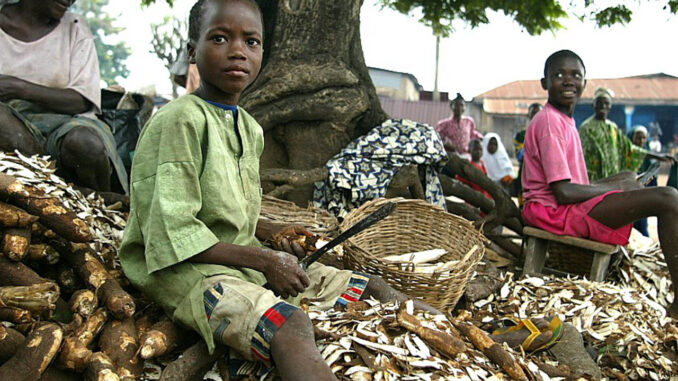
As the cost of poultry and animal feeds increases daily, many farms and hatcheries have been forced to halt their operations.
Sourcing of feed raw materials, especially the main ingredient – maize was identified as the main cause of this, forcing stakeholders to desperately seek for maize substitute.
Now, their efforts seem to have paid off, as a new discovery has shown the potential of cassava peels as substitute to partially replace maize in feed formulation.
Though the use of cassava peels for livestock feed is an age-long practice, where farmers’ sun dry the peels in small quantities as a feed resource, but researchers have successfully modified this conventional method by turning the peels into High Quality Cassava Peel (HQCP) mash.
This is also good news for cassava farmers to generate income from the crop-waste by-product, which has always been left in large heaps to rot or set on fire. Based on statistics, Nigeria harvests about 59 million tonnes of the produce yearly, resulting in about 15 million tonnes of wet cassava peels.
According to the process developed by the International Livestock Research Institute (ILRI) and the International Institute for Tropical Agriculture (IITA), wet cassava peels are grated, dried, dehydrated and turned into the HQCP mash, with a moisture content of about 10-12 per cent. With that, the final product can be stored for about six months.
In the words of the IITA agricultural economist, Iheanacho Okike, who led the development of the innovation, the HQCP mash is a perfect animal feed ingredient in cassava-producing countries. “It’s energy-rich and has a nutritional value close to maize. When used in animal feed, it reduces the amount of maize needed, which lowers costs and frees up valuable grain for human consumption.”
Reports of feeding trials conducted with small and large-scale farmers across the country, show that the mash improves feed conversion efficiency. The trials show that in broiler diets, specifically, the mash could replace 20 per cent or 1.5 million tonnes of maize going into manufactured feed.
For layers, it was revealed that the cassava mash replaced 35 per cent of the birds’ feed ration and resulted in a 10-15 per cent reduction in the cost of feed for local farmers. In Pigs, the cassava mash can replace up to 75 per cent of maize in the diet of growing pigs with about four per cent reduction in cost per kg weight gain without any adverse effect on the growth performance.
Trilled by this development, industry players have described the conversion of the cassava waste as a game-changer, noting that it is a viable industry in Nigeria with the potential of not only lessening the challenges of poultry farmers, but will help cassava farmers get additional income.
The Country Representative of ILRI, who is a livestock feed specialist, Tunde Amole, who confirmed that the cassava waste will reduce the challenges faced by farmers, said it will resolve the near-perennial animal feed scarcity crisis, pastoralist-farmers conflicts over natural resources and the high costs of compound feeds in Nigeria and other cassava-producing countries in Africa.
The Director General, Premier Agribusiness Academy, Francis Toromade, who confirmed the research, described it as a good development. He however, added that the cassava peels does not directly substitute maize because they don’t have the same amino acid level profile, “but at least, its availability will reduce the quantity of maize that farmers and feed producers will be putting in the ration.”
He noted that people leaving the poultry business is not really because of the high cost of feed but the high cost of production, which seems to be unaffordable at present.
“There are two things – cost and revenue are factors that determine if people are going to stay in business or otherwise. You have to embrace anything you can to eliminate your cost. If you cannot eliminate your cost, find means of reducing the cost.
“On the revenue side, you must always look for anything that will raise your revenue. The moment your revenue is increased, it will ease your cost and that’ll enhance your profitability. There are two popular saying — Turnover is vanity, profit is the sanity and cash flow is the reality. Some people even say that the cash is the king, the profit is the kingdom, when there is no kingdom, there is no throne, that’s just it.”
Founder of Menitos Farms, Tolulope Daramola, said if farmers have a choice, they would all go for maize-based feed. “The cassava peels have always been ruminant food, so it was not exact waste like that. My own is that it has always been food for bigger animals and I am yet to see a proper unbiased testing done on its benefits for poultry.
“It’s definitely good news for cassava farmers as it means more demand and better prices for cassava peels especially dried ones. But except they can have a proven standard for processing it for small birds, it won’t be my preferred choice for a while.”
Daramola said change of feed or feed ingredients could affect livestock positively or negatively. “For example, Salmonella is more likely in feeds made from cassava if it’s not properly processed. Even for humans, if not processed well, cassava can be harmful. The processing of garri for human consumption is one area where cassava processing in the country remains tricky.
“Maize remains the best for poultry, it grows within fewer months and it’s easier for them to digest. Preserving it is mainly dehydrating for further processing. Maize should not be the price we pay for the news of cassava in other industries. Stressing one industry for another has never been progressive, especially when both can actually be run side by side.”
END

Be the first to comment